Generation of Circularly Polarized Quasi-Non-Diffractive Vortex Wave via a Microwave Holographic Metasurface Integrated with a Monopole
Abstract
:1. Introduction
2. Design Principle and Procedure
2.1. Design Principle
2.2. Design Procedure
- First of all, the required parameters should be decided before the holographic calculation, including operation frequency (f), size of the aperture (D), depth-of-field of the non-diffracting beam (), the base angle of the equivalent (), topological charge (l) and polarization.
- Afterward, according to the selected parameters, the desired object wave and the reference wave were expressed analytically. The former was related to the charactersitics of the radiated beam, while the latter was associated with the type and location of the feeding source.In the next part, we calculated two linearly polarized holograms ( and ) and obtained their phase hologram distribution ( and ).
- After that, we normalized the holographic phase distribution to the same range and defined the judging threshold (). Following the binary judging criterion, we obtained the slot-type distribution patterns ( and ) generated by two linearly polarized object waves ( and ).
- In the end, we superposed the slot-type distribution patterns ( and ) generated by two linearly polarized object waves to obtain the final slot-type pattern () of the circularly polarized quasi-non-diffractive vortex wave. According to the resulting slot-type pattern, a metasurface with the capability of steering the circularly polarized quasi-non-diffractive vortex wave can be established finally.
3. Modeling, Simulation and Analysis
3.1. Modelling and Simulation of the Unit Cell
3.2. Modelling and Simulation of the Metasurface
4. Discussion
5. Conclusions
Author Contributions
Funding
Institutional Review Board Statement
Informed Consent Statement
Data Availability Statement
Conflicts of Interest
References
- Allen, L.; Beijersbergen, M.W.; Spreeuw, R.; Woerdman, J.P. Orbital angular momentum of light and the transformation of Laguerre-Gaussian laser modes. Phys. Rev. A. 2016, 45, 8185–8189. [Google Scholar] [CrossRef]
- Oemrawsingh, S.S.R.; van Houwelingen, J.A.W.; Eliel, E.R.; Woerdman, E.J.; Verstegen, K.; Kloosterboer, J.G.; Hooft, G.W. Production and characterization of spiral phase plates for optical wavelengths. Appl. Optics. 2004, 43, 688–694. [Google Scholar] [CrossRef] [PubMed]
- Zhang, D.; He, C.; Chen, Q.; Liu, J.; Hong, L. Converged OAM vortex wave generation using EBG-loaded patch array antenna. Int. J. RF Microw. Comput. Aided Eng. 2021, 31, e22711. [Google Scholar] [CrossRef]
- Liu, T.; Feng, R.; Yi, J.; Burokur, S.N.; Mao, C.; Zhang, H.; Werner, D.H. All-dielectric transformation medium mimicking a broadband converging lens. Opt. Express. 2018, 26, 20331–20341. [Google Scholar] [CrossRef] [PubMed]
- Amini, A.; Oraizi, H. Adiabatic Floquet-wave expansion for the analysis of leaky-wave holograms generating polarized vortex beams. Phys. Rev. Appl. 2021, 15, 034049. [Google Scholar] [CrossRef]
- Rouhi, K.; Rajabalipanah, H.; Abdolali, A. Multi-bit graphene-based bias-encoded metasurfaces for real-time terahertz wavefront shaping: From controllable orbital angular momentum generation toward arbitrary beam tailoring. Carbon 2019, 149, 125–138. [Google Scholar] [CrossRef]
- Hu, F.; Guo, W.; Rong, Q.; Zhang, L.; Zhou, Y. Electrically controlled terahertz binary coder based on hysteresis of vanadium dioxide embedded modulator. J. Lightwave Technol. 2021, 39, 2476–2481. [Google Scholar] [CrossRef]
- Bai, X.; Kong, F.; Sun, Y.; Wang, G.; Qian, J.; Li, X.; Cao, A.; He, C.; Liang, X.; Jin, R.; et al. High-efficiency transmissive programmable metasurface for multimode OAM generation. Adv. Optical. Mater. 2020, 8, 2000570. [Google Scholar] [CrossRef]
- Ma, L.; Chen, C.; Zhou, L.; Jiang, S.; Zhang, H. Single-layer transmissive metasurface for generating OAM vortex wave with homogeneous radiation based on the principle of Fabry-Perot cavity. Appl. Phys. Lett. 2019, 114, 81603. [Google Scholar] [CrossRef]
- Zhang, S.; Huo, P.; Zhu, W.; Zhang, C.; Chen, P.; Liu, M.; Chen, L.; Lezec, H.J.; Agrawal, A.; Lu, Y.; et al. Broadband detection of multiple spin and orbital angular momenta via dielectric metasurface. Laser Photonics Rev. 2020, 14, 2000062. [Google Scholar] [CrossRef]
- Luo, Z.; Wang, Q.; Zhang, X.G.; Wu, J.W.; Dai, J.Y.; Zhang, L.; Wu, H.T.; Zhang, H.C.; Ma, H.F.; Cheng, Q.; et al. Digital nonlinear metasurfaces: Intensity-dependent metasurface with digitally reconfigurable distribution of nonlinearity. Adv. Optical Mater. 2019, 7, 1900792. [Google Scholar] [CrossRef]
- Luo, Z.; Ren, X.; Wang, Q.; Cheng, Q.; Cui, T.J. Anisotropic and Nonlinear Metasurface for Multiple Functions. Sci. China Inf. Sci. 2021, 1–10. [Google Scholar] [CrossRef]
- Yu, N.; Genevet, P.; Kats, M.A.; Aieta, F.; Tetienne, J.-P.; Capasso, F.; Gaburro, Z. Light propagation with phase discontinuities reflection and refraction. Science 2011, 334, 333–337. [Google Scholar] [CrossRef] [PubMed] [Green Version]
- Yang, L.-J.; Sun, S.; Sha, W.E.I. Manipulation of orbital angular momentum spectrum using shape-tailored metasurfaces. Adv. Optical Mater. 2021, 9, 2001711. [Google Scholar] [CrossRef]
- Yang, L.-J.; Sun, S.; Sha, W.E.I. Ultra-wideband reflection-type metasurface for generating integer and fractional orbital angular momentum. IEEE Trans. Antennas Propag. 2020, 68, 2166–2175. [Google Scholar] [CrossRef] [Green Version]
- Lv, H.H.; Huang, Q.-L.; Yi, X.-J.; Hou, J.-Q.; Shi, X.-W. Low-profile transmitting metasurface using single dielectric substrate for OAM generation. IEEE Antennas Wirel. Propag. Lett. 2020, 19, 881–885. [Google Scholar] [CrossRef]
- Zhang, K.; Yuan, Y.; Zhang, D.; Ding, X.; Ratni, B.; Burokur, S.N.; Lu, M.; Tang, K.; Wu, Q. Phase-engineered metalenses to generate converging and non-diffractive vortex beam carrying orbital angular momentum in microwave region. Opt. Express. 2018, 26, 1351–1360. [Google Scholar] [CrossRef]
- Wang, Y.; Zhang, K.; Yuan, Y.; Ding, X.; Yang, G.; Fu, J.; Wu, Q.; Guan, C. 1-bit non-diffractive vortex beam generator based on FSS in microwave region. IEEE Trans. Magn. 2021, 57, 4001504. [Google Scholar] [CrossRef]
- Wu, G.B.; Chan, K.F.; Chan, C.H. 3-D printed terahertz lens to generate higher-order Bessel beams carrying OAM. IEEE Trans. Antennas Propag. 2020, 69, 3399–3480. [Google Scholar] [CrossRef]
- Liu, H.; Xue, H.; Liu, Y.; Li, L. Generation of multiple pseudo Bessel beams with accurately controllable propagation directions and high efficiency using a reflective metasurface. Appl. Sci. 2020, 10, 7219. [Google Scholar] [CrossRef]
- Meng, X.; Chen, X.; Yang, L.; Xue, W.; Zhang, A.; Sha, W.E.I.; Cheng, Q. Launcher of high-order Bessel vortex beam carrying orbital angular momentum by designing anisotropic holographic metasurface. Appl. Phys. Lett. 2020, 117, 243503. [Google Scholar] [CrossRef]
- Smith, D.R.; Yurduseven, O.; Mancera, L.P.; Bowen, P. Analysis of a waveguide-fed metasurface antenna. Phys. Rev. Appl. 2017, 8, 054048. [Google Scholar] [CrossRef] [Green Version]
- Yurduseven, O.; Smith, D.R. Dual-Polarization Printed Holographic Multibeam Metasurface Antenna. IEEE Antennas Wirel. Propag. Lett. 2017, 16, 2738–2741. [Google Scholar] [CrossRef]
- Yurduseven, O.; Lee, C.; David, G.-O.; Ettorre, M.; Sauleau, R.; Chattopadhyay, G.; Fusco, V.; Chahat, N. MultiBeam Si/GaAs holographic metasurface antenna at W-band. IEEE Trans. Antennas Propag. 2020, 69, 3523–3528. [Google Scholar] [CrossRef]
- Yurduseven, O.; Marks, D.L.; Gollub, J.N.; Smith, D.R. Design and analysis of a reconfigurable holographic metasurface aperture for dynamic focusing in the Fresnel zone. IEEE Access. 2017, 5, 15055–15065. [Google Scholar] [CrossRef]
- Imani, M.F.; Gollub, J.N.; Yurduseven, O.; Diebold, A.V.; Smith, D.R. Review of metasurface antennas for computational microwave imaging. IEEE Trans. Antennas Propag. 2020, 68, 1860–1875. [Google Scholar] [CrossRef] [Green Version]
- Hougne, P.D.; Imani, M.F.; Diebold, A.V.; Horstmeyer, R.; Smith, D.R. Learned integrated sensing pipeline: Reconfigurable metasurface transceivers as trainable physical layer in an artificial neural network. Adv. Sci. 2020, 7, 1901913. [Google Scholar] [CrossRef] [Green Version]
- Durnin, J. Exact solutions for nondiffracting beams. I. The scalar theory. J. Opt. Soc. 1987, 4, 651–654. [Google Scholar] [CrossRef]
- Durnin, J.; Miceli, J.J.; Eberly, J.H. Diffraction-free beams. Phys. Rev. Lett. 1987, 58, 1499–1501. [Google Scholar] [CrossRef]
- Meng, Y.; Yi, J.; Burokur, S.N.; Kang, L.; Zhang, H.; Werner, D.H. Phase-modulation based transmitarray convergence lens for vortex wave carrying orbital angular momentum. Opt. Express 2018, 26, 22019–22029. [Google Scholar] [CrossRef]
- Zhong, Y.C.; Cheng, Y.J. Generating and steering quasi-non-diffractive beam by near-field planar risley prisms. IEEE Trans. Antennas Propag. 2020, 68, 7767–7776. [Google Scholar] [CrossRef]
- Zhong, Y.C.; Cheng, Y.J. Ka-band wideband large depth-of-field beam generation through a phase shifting surface antenna. IEEE Trans. Antennas Propag. 2016, 64, 5038–5045. [Google Scholar] [CrossRef]
- Cai, B.G.; Li, Y.B.; Jiang, W.X.; Cheng, Q.; Cui, T.J. Generation of spatial Bessel beams using holographic metasurface. Opt. Express. 2015, 23, 7593–7601. [Google Scholar] [CrossRef]
- Ettorre, M.; Pavone, S.C.; Casaletti, M.; Albani, M. Experimental validation of Bessel beam generation using an inward Hankel aperture distribution. IEEE Trans. Antennas Propag. 2015, 63, 2539–2544. [Google Scholar] [CrossRef] [Green Version]
- Wu, Y.F.; Cheng, Y.J. Generating and 2-D steering large depth-of-field beam by leaky-wave antenna array with a modified parabolic reflector. IEEE Trans. Antennas Propag. 2020, 68, 2779–2787. [Google Scholar] [CrossRef]
- Zhang, C.; Deng, L.; Zhu, J.; Hong, W.; Wang, L.; Wang, H.; Zeng, T.; Ren, X.; He, X.; Zhao, Z.; et al. A right-handed circularly polarized wave generated by a waveguide-fed holographic metasurface. J. Phys. D Appl. Phys. 2020, 53, 26LT01. [Google Scholar] [CrossRef]
- Strain, M.J.; Cai, X.; Wang, J.; Zhu, J.; Phillips, D.B.; Chen, L.; Lopez- Garcia, M.L.; O’Brien, J.; Thompson, M.G.; Sorel, M.; et al. Fast electrical switching of orbital angular momentum modes using ultra-compact integrated vortex emitters. Nat. Commun. 2014, 5, 4856. [Google Scholar] [CrossRef] [Green Version]
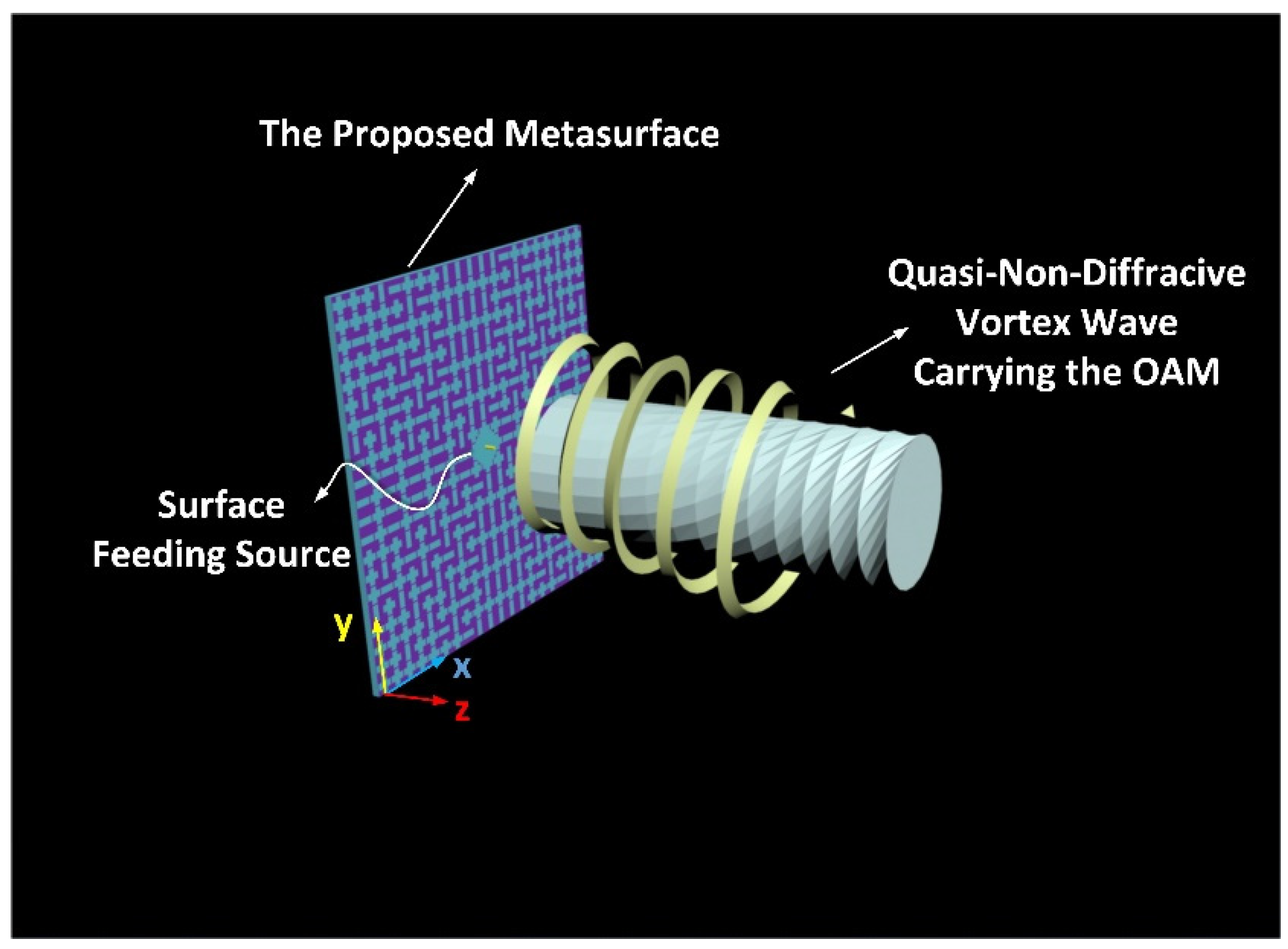
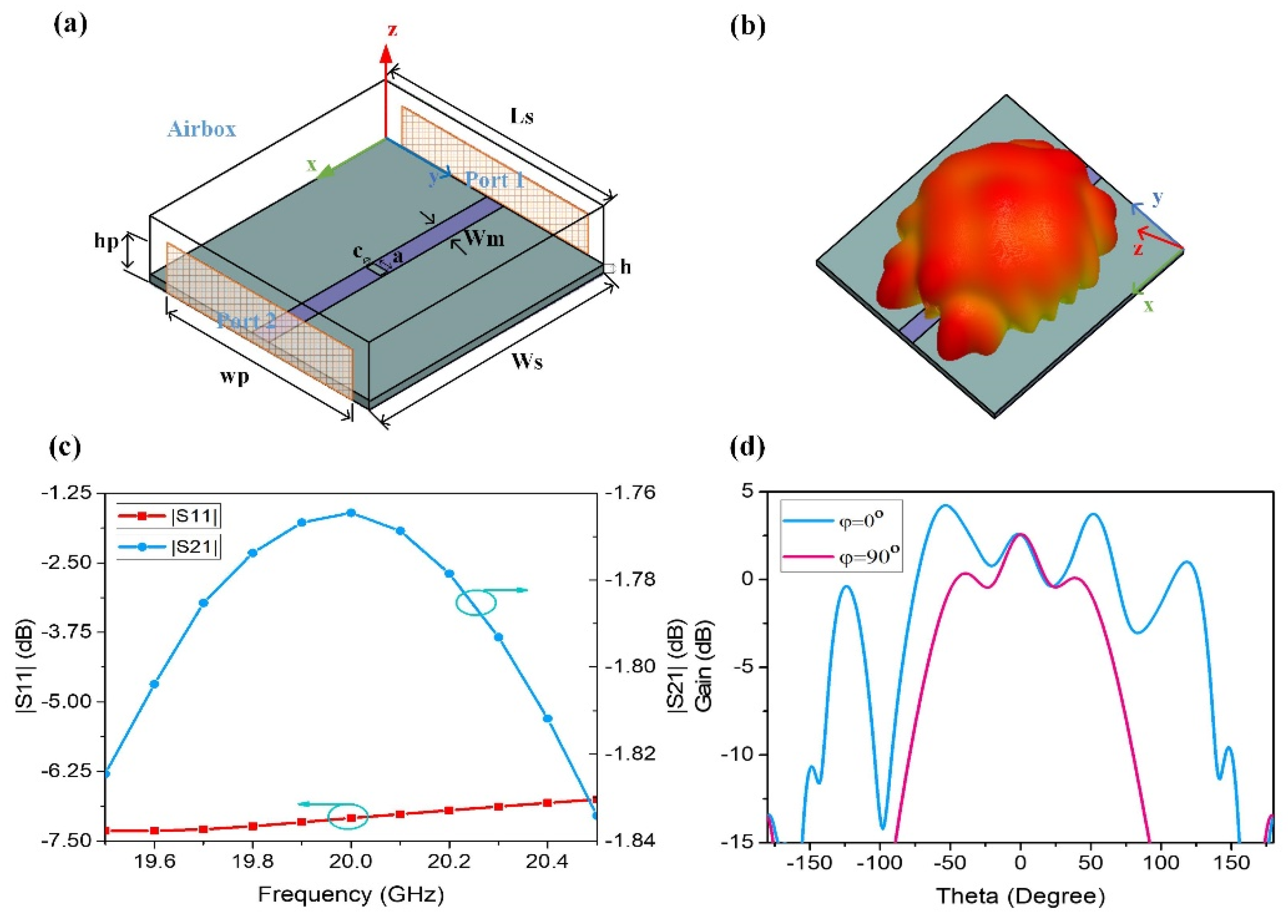
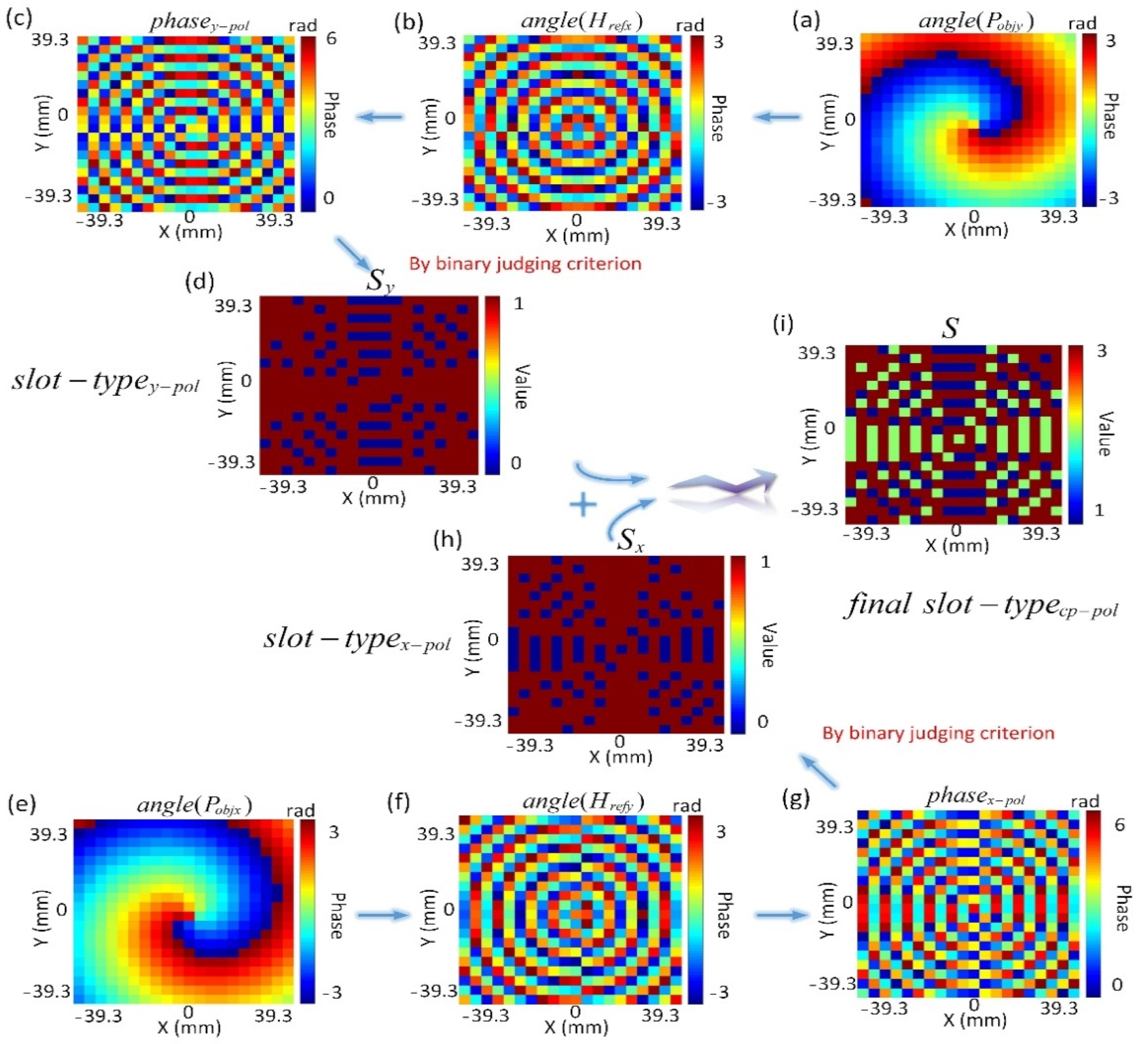
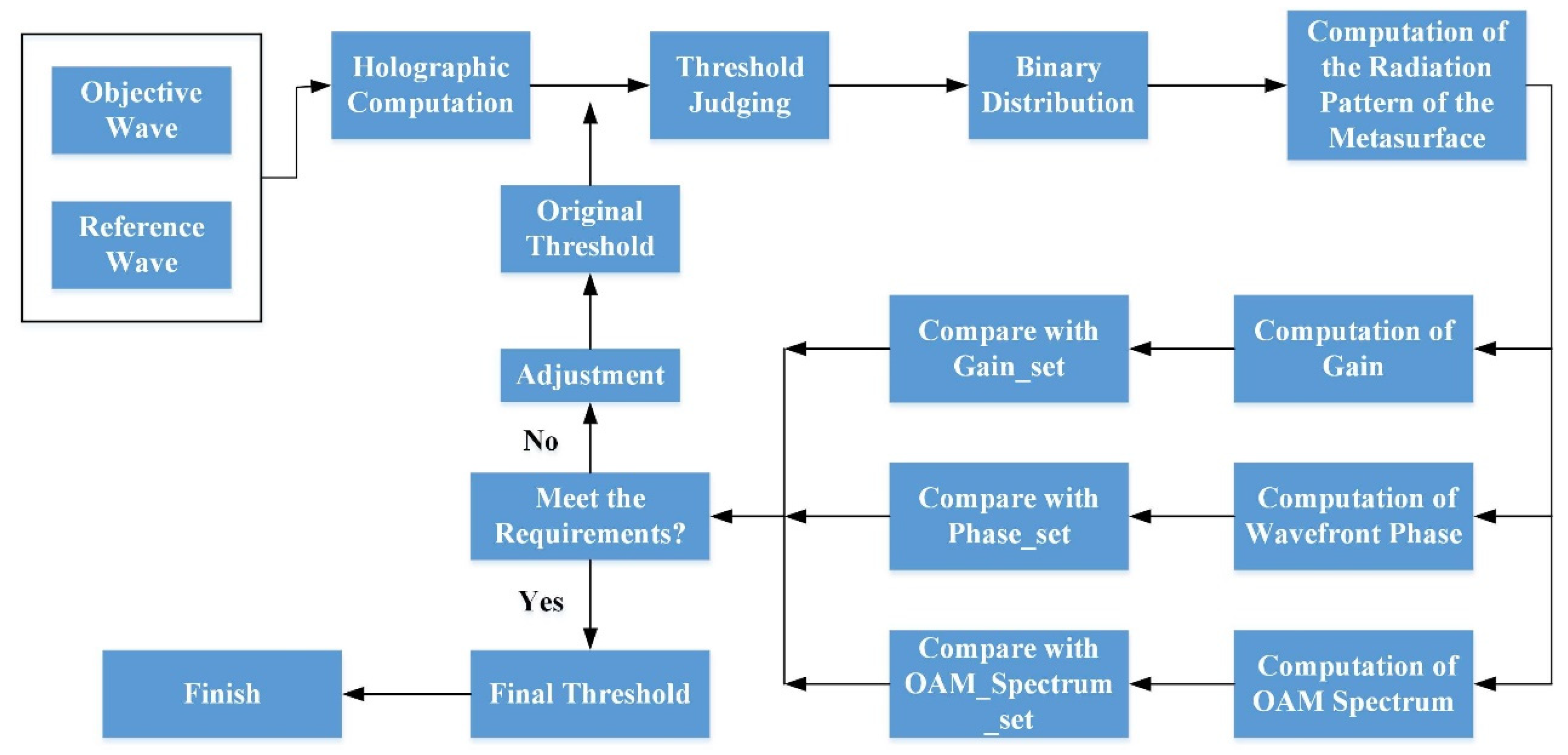
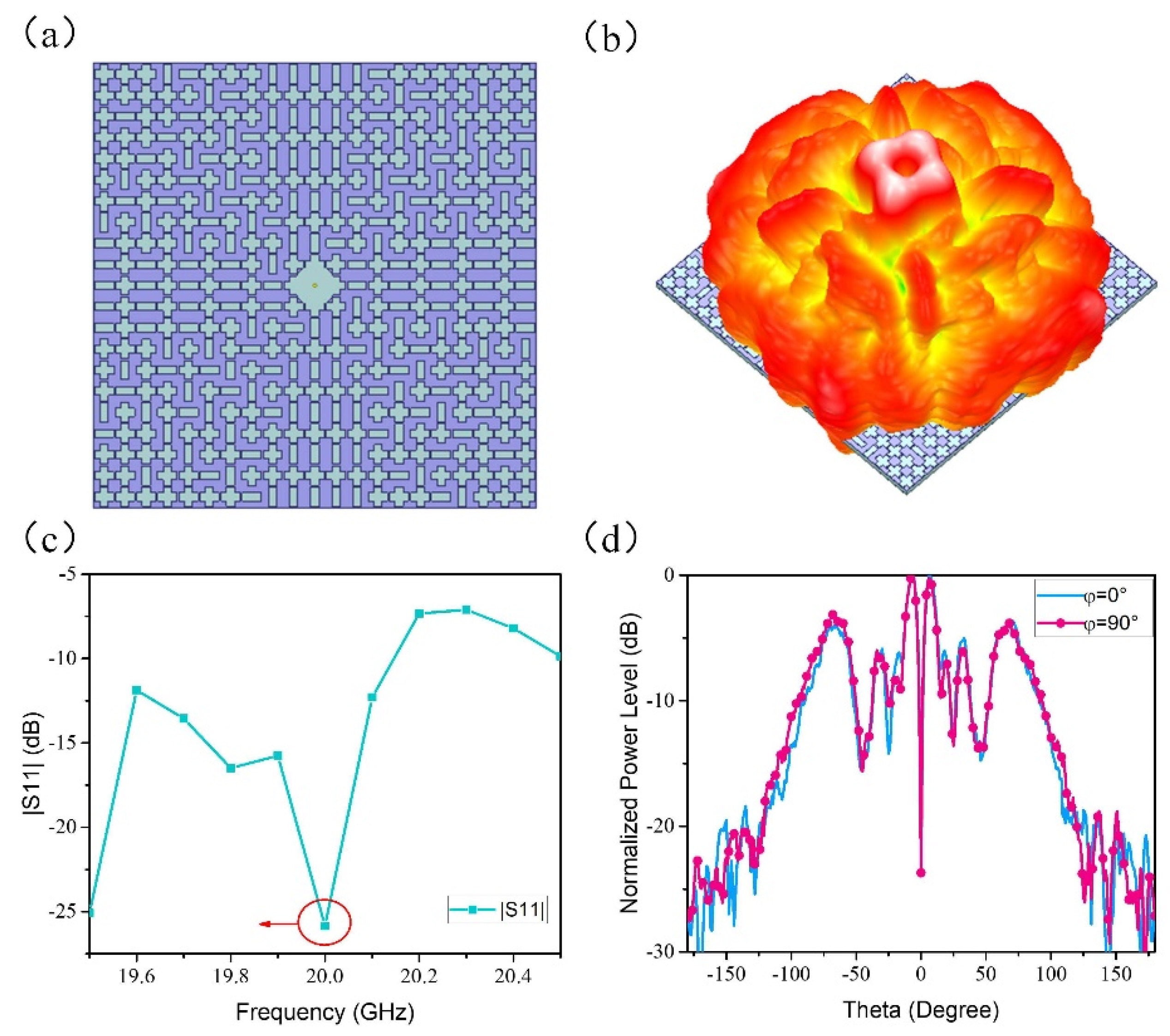
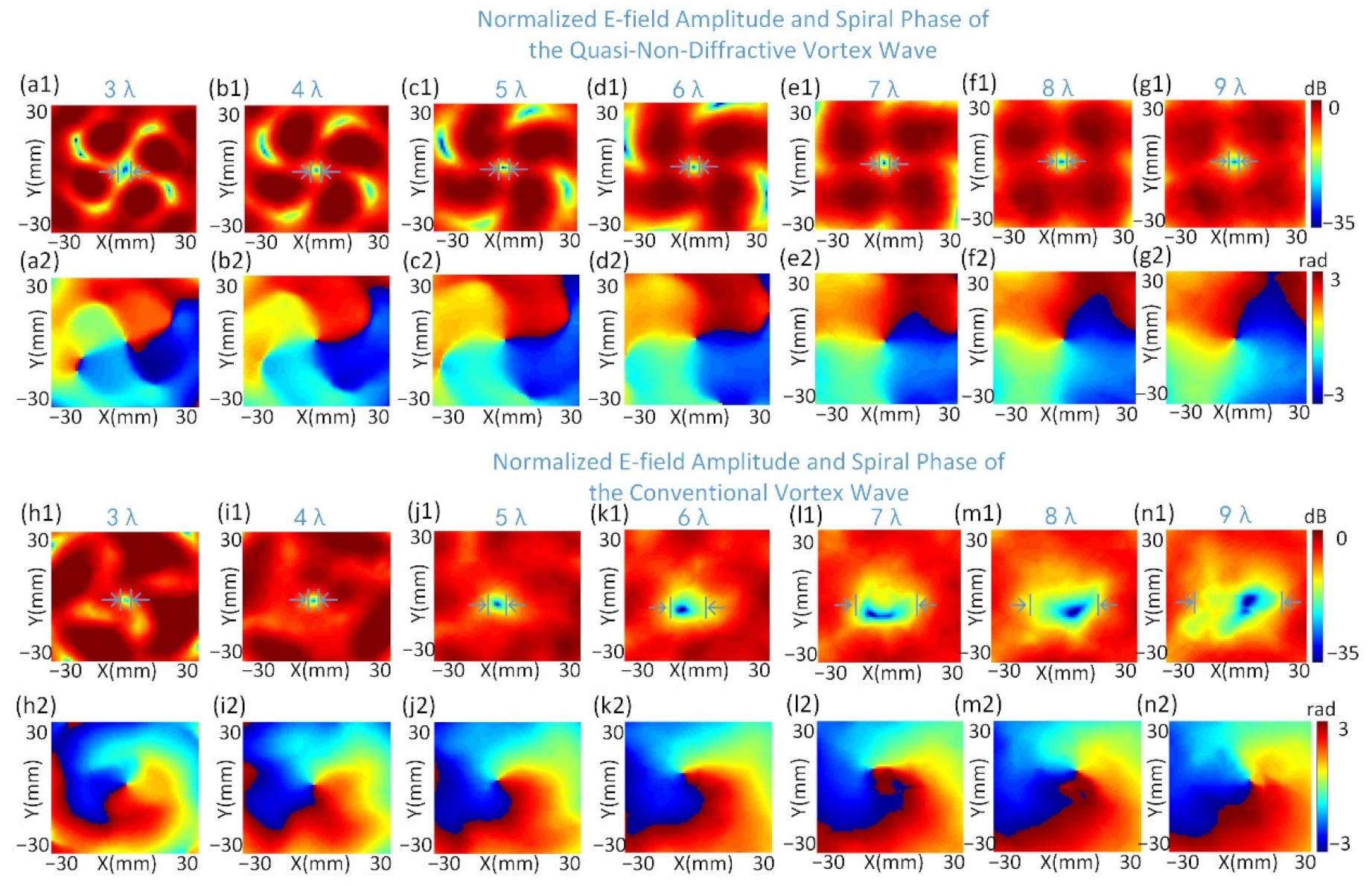

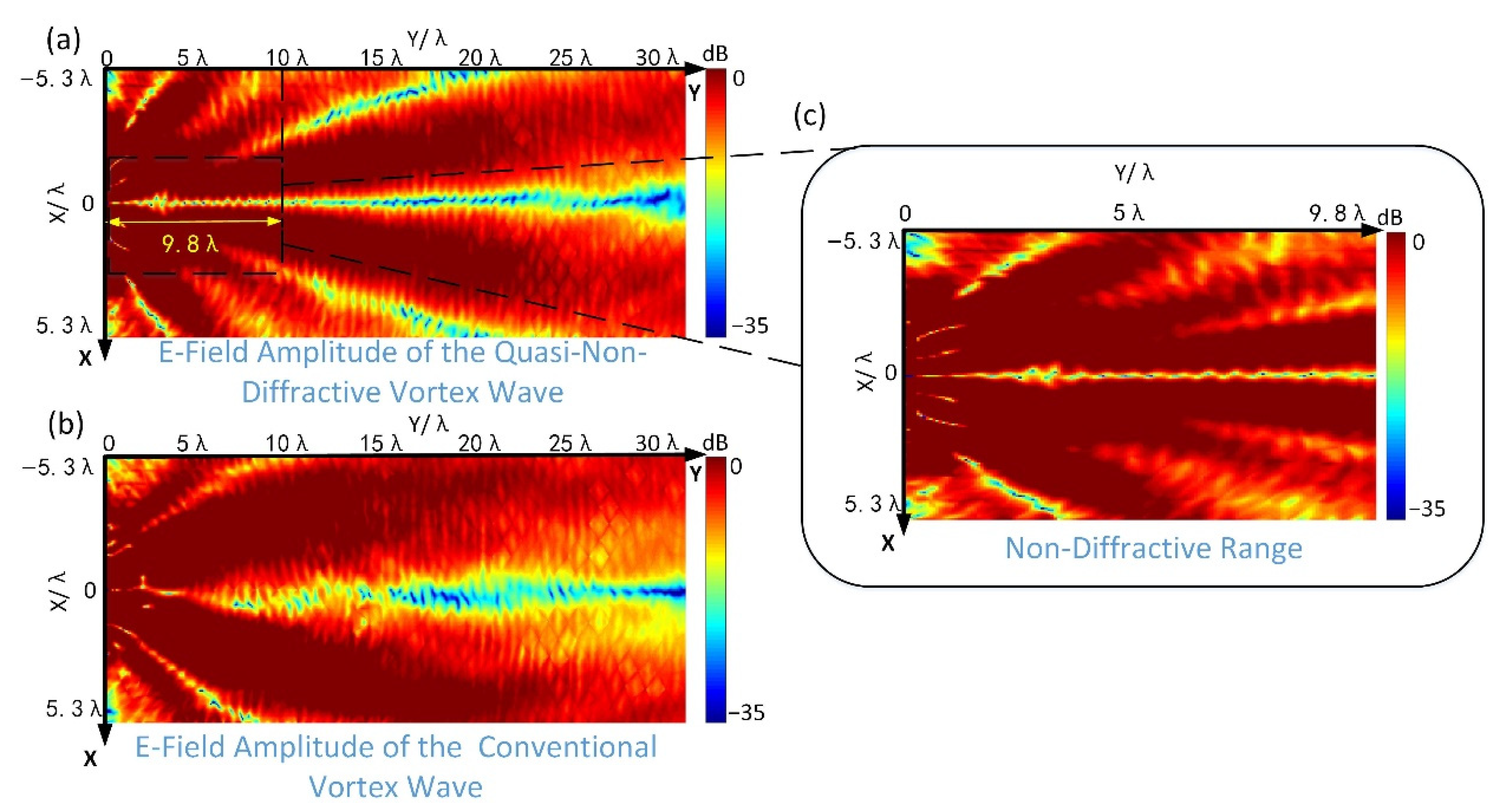

Publisher’s Note: MDPI stays neutral with regard to jurisdictional claims in published maps and institutional affiliations. |
© 2021 by the authors. Licensee MDPI, Basel, Switzerland. This article is an open access article distributed under the terms and conditions of the Creative Commons Attribution (CC BY) license (https://creativecommons.org/licenses/by/4.0/).
Share and Cite
Zhang, C.; Deng, L.; Wang, L.; Chen, X.; Li, S. Generation of Circularly Polarized Quasi-Non-Diffractive Vortex Wave via a Microwave Holographic Metasurface Integrated with a Monopole. Appl. Sci. 2021, 11, 7128. https://doi.org/10.3390/app11157128
Zhang C, Deng L, Wang L, Chen X, Li S. Generation of Circularly Polarized Quasi-Non-Diffractive Vortex Wave via a Microwave Holographic Metasurface Integrated with a Monopole. Applied Sciences. 2021; 11(15):7128. https://doi.org/10.3390/app11157128
Chicago/Turabian StyleZhang, Chen, Li Deng, Ling Wang, Xue Chen, and Shufang Li. 2021. "Generation of Circularly Polarized Quasi-Non-Diffractive Vortex Wave via a Microwave Holographic Metasurface Integrated with a Monopole" Applied Sciences 11, no. 15: 7128. https://doi.org/10.3390/app11157128
APA StyleZhang, C., Deng, L., Wang, L., Chen, X., & Li, S. (2021). Generation of Circularly Polarized Quasi-Non-Diffractive Vortex Wave via a Microwave Holographic Metasurface Integrated with a Monopole. Applied Sciences, 11(15), 7128. https://doi.org/10.3390/app11157128






